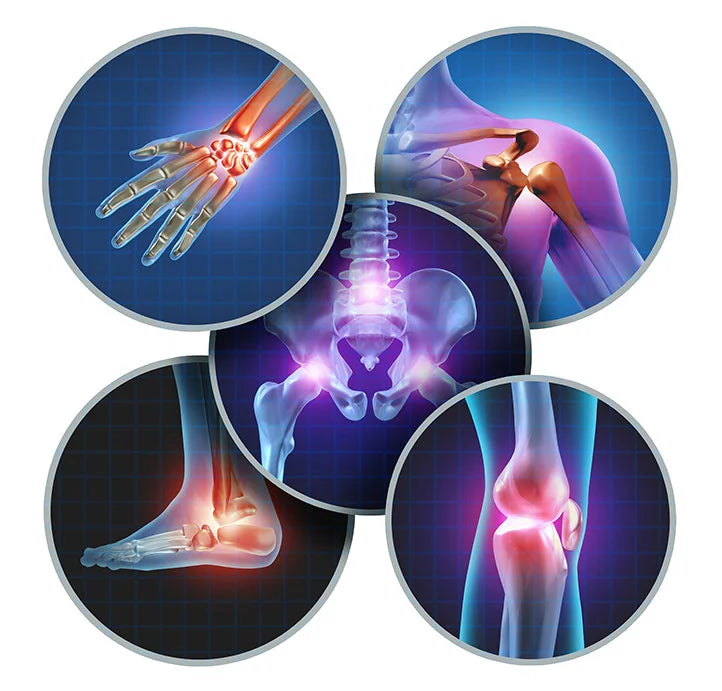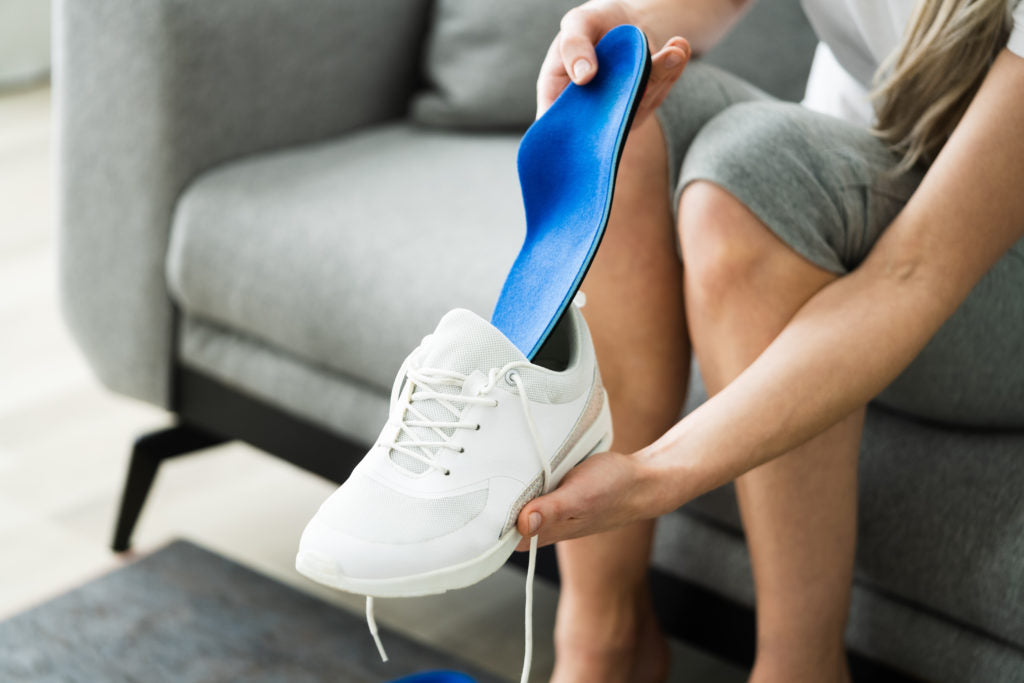
Contrary to popular belief, arthritis is not a single disease but rather a manner of referring to either joint pain or joint-related disease. In fact, there are over 100 types of arthritis and conditions related to arthritis. Arthritis is the most common cause of disability in the United States and while it can affect individuals of every age, gender and ethnicity, it’s more common among women and tends to be more prevalent with age.
The most common symptoms associated with arthritis are reduced range of motion and pain, swelling and stiffness of the joints. Symptoms can be mild to severe and many people find that some days are better than others and that their symptoms come and go. Symptoms often remain stable for years but then frequently worsen with age.
Arthritis can lead to chronic pain which can limit daily activities and negatively impact quality of life.
The 5 most prevalent types of arthritis are:
• Osteoarthritis: The most common type of arthritis is osteoarthritis (OA). OA is often referred to as “wear and tear arthritis” because it occurs when the cartilage between the bones breaks down. When this happens, pain and swelling result and movement becomes impaired. Any joint can be affected by OA. However, it’s most common in the knees, hips, hands, neck and back. While OA can happen at any age, it’s most prevalent in women and individuals over 50.
• Rheumatoid Arthritis: Rheumatoid arthritis (RA) is an autoimmune disease that occurs when the immune system attacks the lining of the joints. RA usually affects the knees, hands and ankles but other parts of the body can be affected as well. RA most frequently develops in middle age and is more common among women. RA may also be hereditary.
• Psoriatic Arthritis: Psoriatic arthritis (PsA) is an inflammatory disease that mostly affects the skin and joints. People with PsA often experience red, painful and itchy patches of skin with a silver/white cast. These patches usually occur on the scalp, elbows and knees. The joints most commonly affected by PsA are the knees, ankles, wrists and fingers.
• Gout: Gout is an inflammatory disease that’s most common among men, particularly men over 40. Typically starting in the big toe, gout results in sudden and intense pain. Other joints can be affected as well.
• Lupus: Lupus in an autoimmune disease that can cause inflammation in any part of the body. Most commonly affected are the skin, joints and internal organs.
If you’re experiencing persistent pain that’s interfering with daily activities, see your doctor. Diagnosing arthritis can be a lengthy task that often involves compiling health information and running tests. Your doctor will evaluate your symptoms, overall health, lifestyle and family history in addition to conducting a physical exam.
Your doctor may also order tests to help make a diagnosis. X-rays are most commonly used for imaging but an ultrasound or an MRI may be necessary. Your doctor may also choose to conduct other types of tests such as nerve, blood, fluid and tissue tests in order to help diagnose or to rule out specific types of arthritis.

Arthritis symptoms can often be managed with a combination of lifestyle changes and treatments. Be sure to work with your doctor to come up with a plan. Lifestyle changes can include:
•Get moving –Exercise can help reduce pain and improve range of motion. Work with your doctor or physical therapist to find an effective routine that eases stiffness without putting additional pressure on the joints.
•Maintain a healthy weight –Losing even a few pounds can alleviate stress on painful joints.
•Don’t smoke - As smoking can increase arthritis-related pain.
Treatments can include:
• Over-the-counter pain relievers such as ibuprofen (Advil, Motrin) and Naproxen sodium (Aleve) can help relieve pain and reduce inflammation. Acetaminophen (Tylenol) can help provide pain relief but doesn’t address inflammation.
• Topical creams that contain ingredients such as capsaicin, lidocaine, menthol, salicylates, and diclofenac sodium (Dr. Scholl’s® Arthritis Pain Reliever) can be applied directly to painful areas for immediate relief.
• Corticosteroids may be prescribed in order to suppress the immune response that causes inflammation.
• Prescription medications such as opioids, biologics, immunosuppressants and prescription-strength NSAIDs (non-steroidal anti-inflammatory drugs) may be prescribed for severe pain that does not respond to over-the-counter pain relievers.
What causes arthritis?
The exact cause of most types of arthritis is unknown. Gout is the only type of arthritis where the cause is fully understood. Gout is caused by an accumulation of urate crystals in the affected joint. These crystals form as the result of too much uric acid in the blood.
While it’s not clear exactly how you get arthritis in most cases, there are factors that can increase the risk of developing the condition. These include:
Excess weight – People who are overweight are at an increased risk of certain types of arthritis due to excessive pressure and stress on the joints.
Joint injuries – Joints that have been injured are more prone to certain types of arthritis due to long-term damage.
Smoking – People who smoke are at an increased risk of certain types of arthritis due to the joint-damaging effects of cigarettes.
What does arthritis feel like?
While arthritis symptoms vary between individuals and depending on the type of arthritis, common symptoms include pain and stiffness of a particular joint or multiple joints. The area may be tender and sore to the touch and in many cases, range of motion is limited. Swelling is also common. There are specific symptoms associated with different type of arthritis:
Gout – This type of arthritis most commonly affects the big toe. The pain usually comes on suddenly and severely with swelling and redness at the base of the big toe.
Lupus – This type of arthritis typically causes joint pain and swelling along with tiredness and other potential symptoms such as headaches, sensitivity to light and mild fever. People with certain types of lupus may also experience skin issues such as sores, rashes and hair loss.
Osteoarthritis – The most common type of arthritis, osteoarthritis causes pain and swelling in the joints, especially after a long, active day. Stiffness is also common, most notably after long periods of rest or after waking up in the morning. Muscle weakness and reduced range of motion are also common. Many people with osteoarthritis report a cracking or clicking sound when bending the affected joints.
Rheumatoid arthritis – This type of arthritis tends to affect multiple joints, causing pain, swelling and inflammation. Stiffness is common after waking up in the morning, and it can last a half hour or even longer.
Psoriatic arthritis – Also called PsA, psoriatic arthritis can cause a number of joint issues including pain, tenderness, swelling and stiffness. Fingers and toes that are affected often swell up to a point where they look like sausages. PsA can also cause fatigue as well as eye symptoms such as redness and discomfort. In some cases, those with PsA will notice changes in their toenails and fingernails. The nails may crumble or form dents. They may also change color, becoming yellow or brown.
What is arthralgia?
Arthralgia is the term for discomfort (such as pain and stiffness) of a joint or multiple joints of the body such as the knees, hips and joints of the toes and fingers. Arthritis is a common cause of arthralgia.
How to prevent arthritis
There is no way to prevent arthritis completely. However, there are ways to reduce the risk of developing certain types of arthritis. These include:
Maintain a healthy weight since excess weight can put pressure on the joints, leaving them more susceptible to arthritis.
Don’t smoke since smoking can cause joint damage which can contribute to or worsen arthritis.
Take care when exercising or engaging in any activity that makes you prone to joint injuries.
Consider protective attire and equipment such as toe protective shoes along with elbow and knee pads. When possible, avoid sports and activities that have a high risk of injury.
Is arthritis genetic?
There is a genetic link with certain types of arthritis such as rheumatoid arthritis, lupus and osteoarthritis. Although it’s not entirely clear how genes play a role, people are more likely to develop some types of arthritis if a parent or a sibling has had the disease.
What are the symptoms of rheumatoid arthritis?
Symptoms of rheumatoid arthritis include joint pain and stiffness that can last for a significant period of time, several weeks or even longer. More advanced cases of rheumatoid arthritis can cause swelling and even visible redness of affected joints. Stiffness is most common in the morning after first getting out of bed. The stiffness can last 30 minutes or longer in some cases. Rheumatoid arthritis usually affects multiple joints. The smaller joints of the hands are often the first to experience symptoms. It’s common for joints on both sides of the body to be affected. Some people also experience tiredness and a mild fever. The symptoms of rheumatoid arthritis often come and go.
What does arthritis look like?
Arthritis does not always produce visible symptoms and when it does, the symptoms will vary depending on the severity and type of arthritis. There are visible symptoms that are typically associated with specific types of arthritis. These include:
Gout – The joint at the base of the big toe is the most commonly affected joint in people who have gout although other joints can be affected as well. The base of the big toe will usually become red and swollen.
Lupus – Some people with lupus will develop a rash on the face or body. Depending on the type of lupus, the rash can take on different shapes and affect different areas of the face and body. Some people with lupus develop a distinctive butterfly-shaped rash that covers the cheeks along with the bridge of the nose. Rashes associated with lupus are usually red and scaly, and they can be triggered or made worse by sunlight and fluorescent lights. If the rash affects the scalp, hair loss can occur.
Osteoarthritis – While in its early stages osteoarthritis might not produce visible symptoms, as it progresses, it can cause swelling, bumps and deformities of the affected joints. For example, if the hands are affected, they can appear unusually large and misshapen.
Rheumatoid arthritis – The hands are usually the first body parts to be affected by rheumatoid arthritis and it’s common for both hands to be affected. The wrists and knuckles may appear swollen at first but as the disease progresses, the fingers may become deformed, appearing in a twisted fashion. If the feet are affected, they may develop bumps and the toes may become deformed. Rheumatoid arthritis can also cause redness in the eyes.
Psoriatic arthritis – A common visual symptom of psoriatic arthritis is significant swelling of the fingers or toes. Some people report that their swollen digits look like sausages. Nail issues are also associated with psoriatic arthritis. The nails of fingers and toes may become discolored and crumble or develop pits or dents. Psoriatic arthritis can also cause red eyes.
Is joint pain a symptom of COVID?
Yes, in some cases, joint pain can be a symptom of COVID-19. However, joint pain is one of many symptoms associated with COVID-19 and is not usually a sole indicator of an infection.
What helps arthritis?
There are a number of solutions for arthritis, from lifestyle changes to doctor prescribed treatments. These include:
Physical activity – Many people with arthritis shy away from exercise because it can be painful. However, exercise actually helps joint pain. Be sure to consult with your healthcare provider before starting an exercise plan.
Lose weight – If you’re overweight, ask your healthcare provider for help achieving a healthy weight as this can take pressure off of painful joints.
Orthotics – Shoe orthotics can improve the body’s alignment and provide extra support to reduce pressure on painful, arthritic joints.
Over-the-counter treatments – OTC pain relieving oral medications and topical creams are available to help relieve arthritis pain. Some of these products are also effective for inflammation. Ask your healthcare provider before considering any OTC medications.
Prescription treatments – In some cases doctors will prescribe stronger medications in order to relieve pain and reduce joint inflammation.
What does arthritis in the knee feel like?
Symptoms associated with arthritis in the knee will vary depending on the individual affected, the type of arthritis, and how advanced the condition is.
Osteoarthritis is the most common type of arthritis that affects the knee although other types of arthritis can also involve the knees. Osteoarthritis is often referred to as wear and tear arthritis because it typically occurs in people over 50 following decades of wear on the joints. As cartilage breaks down, the bones of the knee may rub together which can be painful.
Arthritic knees can also become stiff and swollen, and it’s common to experience a reduced range of motion. People with arthritis in the knee may find that their knees lock or buckle during certain types of movement such as bending. The pain and stiffness in the knee may be worse after getting up in the morning or following periods of rest. It may also be worse following intense physical activity.
Additional Resources
• https://www.mayoclinic.org/diseases-conditions/gout/symptoms-causes/syc-20372897
• https://www.cdc.gov/arthritis/basics/risk-factors.htm
• https://www.ncbi.nlm.nih.gov/pmc/articles/PMC4284707/
• https://www.hopkinsmedicine.org/health/conditions-and-diseases/arthritis/septic-arthritis
• https://www.webmd.com/arthritis/understanding-arthritis-symptoms
• https://www.lupus.org/resources/common-symptoms-of-lupus
• https://www.arthritis.org/diseases/osteoarthritis
• https://www.arthritis.org/diseases/rheumatoid-arthritis
• https://www.psoriasis.org/about-psoriatic-arthritis/
• https://www.webmd.com/arthritis/psoriatic-arthritis/psa-hands-fingers-nails
• https://www.webmd.com/arthritis/understanding-arthritis-basics
• https://www.mayoclinic.org/diseases-conditions/lupus/symptoms-causes/syc-20365789
• https://www.mayoclinic.org/diseases-conditions/coronavirus/in-depth/coronavirus-long-term-effects/art-20490351
• https://www.healthline.com/health/lupus-pictures#ring–shaped-rash
• https://www.lupus.org/resources/how-lupus-affects-the-skin
• https://www.arthritis.org/diseases/more-about/osteoarthritis-of-the-hands
• https://www.healthline.com/health/rheumatoid-arthritis-pictures#hands
• https://www.mayoclinic.org/diseases-conditions/rheumatoid-arthritis/expert-answers/rheumatoid-arthritis/faq-20057897
• https://orthoinfo.aaos.org/en/diseases–conditions/arthritis-of-the-knee/


